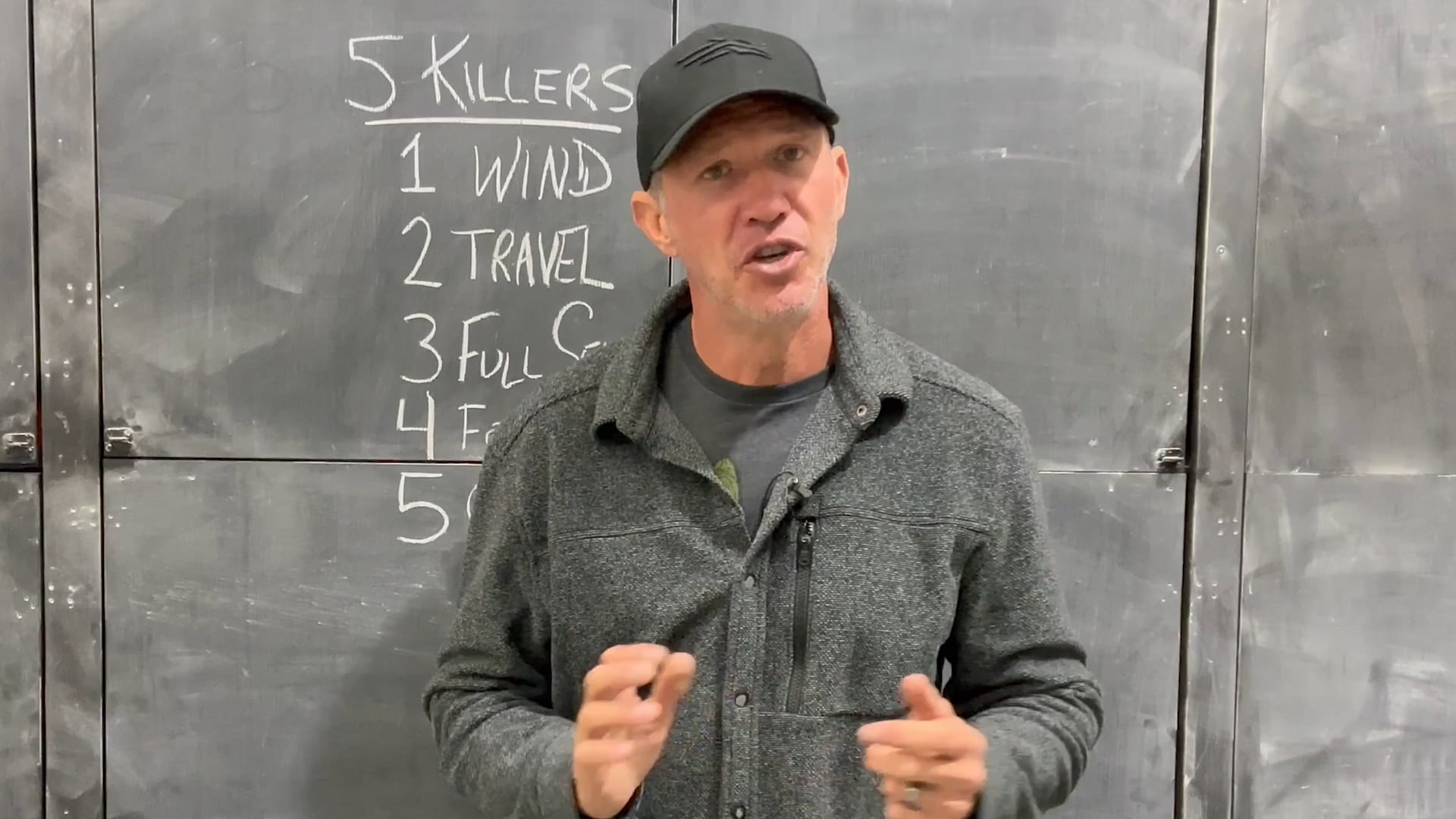We’ve all been there: You scouted for weeks, picked the perfect tree, and hung your stand with surgical precision.
Then, one careless decision sends the buck you’ve been chasing into the next county.
Bowhunting success rarely comes down to having the latest gear or the fastest bow. Instead, it’s about avoiding the mistakes that educate deer and torch your hunting spots. These errors can turn a promising location into a dead zone faster than you can say “I should’ve known better.”
Today, I’m breaking down the five hunt-killers that’ll destroy your chances at harvesting whitetails. These season-defining blunders burn your best spots and educate every deer in the area.
1. Ignoring the Wind
If you’re not playing the wind, you’re hunting recklessly. You’re rolling the dice, and when it comes to whitetails, the house always wins.
A whitetail’s nose is its superpower. Of all their senses, smell is the one they never second-guess. That nose has evolved over thousands of years to detect danger, and it works with remarkable precision.
Sure, there are plenty of scent containment systems on the market. You’ve got sprays, cover scents, electronic devices, and specialized clothing. These products can certainly help in a pinch, but none of them are 100% effective. Sometimes they’ll bail you out of a bad situation, but they’re not a substitute for proper wind strategy.
Before you consider which stand to hunt, ask yourself, “Is the wind right for this location?” This includes not just your stand location but your entire travel route in and out. If the wind is blowing your scent toward where you expect deer to approach, you’re already setting yourself up for failure.
I like to use HuntWise’s WindCast feature to check wind direction before I head out. It shows me exactly how my scent will disperse from each stand location, so I can pick the right spot based on current conditions. This has saved me from making bad decisions more times than I can count.
Mature bucks trust their nose above all else. If you ignore this fact, your chances of success will vanish with every shifting breeze.
2. Careless Travel To and From Stands
How you get to and from your hunting location is almost as important as your hunting location itself. During the rut, your chances of success skyrocket when you don’t have to travel to and from your locations during daylight hours.
Sitting all day isn’t easy, and not everyone has the vacation time to make it happen. But if you’re entering or exiting your stand during daylight, you need to be careful about how you move.
Each time you walk to your stand, you lay a scent trail. When you leave midday and return in the afternoon, that’s two more trails. Then you exit after dark. That’s four human scent trails crisscrossing your hunting area in a single day.
Any deer crossing those paths immediately knows there’s been human presence nearby, and your opportunity for success plummets.
I prioritize silent movement above everything else. If I have to choose between multiple stand locations, I’ll often pick the one with the easiest, quietest access route over one that might have slightly better deer activity but requires noisy travel.
This is why I’ve always advocated for having some stands that are close to access points: near a road, trailhead, or parking area. These spots are perfect for midday hunts when you can’t commit to an all-day sit but still want to maximize your chances during the limited time you have.
3. Going “Full Send” When Bored
An hour in a treestand can feel like a day and a half. A full day can feel like a week. When boredom sets in, the temptation to fool around becomes irresistible.
Maybe you’ve got a small game tag in your pocket, and that squirrel chattering nearby starts looking like a worthy target. This impulse to go “full send” on anything that moves is a hunt-killer, especially during the rut.
Think about how a mature buck behaves when he’s cruising for does. He doesn’t just stroll into an open field. He slithers up to that field edge, ears forward, completely locked in. He’s listening and watching for other deer, and once he detects something, he circles to get the wind and confirm with his nose.
Now consider what happens when your arrow smacks into a tree trying to skewer that squirrel. Or when you’re fumbling with gear, using binoculars, or making unnecessary movements. That buck you never knew was there just got a full education on your presence.
Small game shots create noise that carries farther than you realize. The commotion of a squirrel running through the leaves barking at you alerts every deer in the area. During the rut, the only thing to go “full send” on is the deer you want to put your tag on. Nothing else.
4. Forcing Hunts Under Poor Conditions
You get a trail camera picture of a giant buck using a certain area, and suddenly you’re chomping at the bit to hunt that spot, regardless of the conditions.
Maybe the wind is wrong, or it’s a tough spot to access quietly, or you have limited time. Instead of being patient, you decide to “force it” and hunt there anyway.
When you force a hunt under poor conditions, you guarantee all the other mistakes: fighting the wind, creating excessive travel disturbance, and increasing the likelihood you’ll get bored and go “full send” on something you shouldn’t.
I’ve learned (often the hard way) that sometimes the best move is to adapt rather than force. If conditions aren’t right for your primary spot, can you be mobile instead? Can you hunt the vicinity but not the exact location? Could you set up in areas with favorable wind conditions and use calling strategies to bring deer to you?
Forcing a hunt when conditions aren’t right is like doubling down on a bad hand in poker. The odds are stacked against you, and you’re likely to burn not just that day’s hunt but the spot for the entire season.
5. Overcalling
The final hunt-killer is overcalling, and like going “full send,” it often stems from boredom.
When you’re sitting all day and nothing’s happening, it’s tempting to start hammering that grunt tube or rattling antlers every 15 minutes just to create some action.
This is a fatal mistake. Deer aren’t used to constant calling in nature. When bucks fight, it happens briefly. When they grunt, it’s occasional. Calling nonstop creates an unnatural situation that makes mature deer suspicious.
I call about once per hour, and only after careful observation. I wait for the sun to come up in the morning and let things settle. Then, I do exactly what a big buck does: I listen, look, and scan my area thoroughly. If the coast is clear with no deer immediately nearby that would pinpoint my location, I might rattle or grunt a few times.
Perhaps most importantly, don’t call to deer you don’t intend to shoot. This seemingly innocent practice educates deer about human presence. When a young buck hears your call, investigates, and determines a human made that sound, you’ve just created a more wary deer that’ll be harder to hunt in the future.
Keep the process in mind: deer hear a call, look toward the sound, and circle downwind to smell what made it. When they catch your scent, the jig is up. They now associate that calling sound with human danger.
Avoiding These Killers Leads to Success
These five hunt-killers (ignoring the wind, careless travel, going “full send,” forcing poor conditions, and overcalling) will decimate your chances of consistently harvesting mature whitetails.
The good news is that they’re all completely avoidable with disciplined hunting practices. By respecting the wind, minimizing your travel impact, maintaining stand discipline, hunting only when conditions are right, and calling sparingly, you boost your odds of success.
Keep these five hunt-killers in mind every time you head to the woods, and your tag will find its way onto a buck’s antler sooner rather than later.






 massmonopoly
massmonopoly